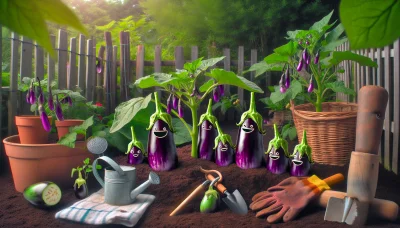How to eat persimmon Quiz
Test Your Knowledge
Question of
How to Eat Persimmon: A Gardener's Guide
Persimmons are a unique and flavorful fruit that have been enjoyed around the world for centuries. Not only are they delicious, but they also offer a variety of nutritional benefits. Rich in vitamins A and C, persimmons can help improve eye health and boost the immune system. They also contain antioxidants that may reduce inflammation and lower the risk of certain chronic diseases. Whether eaten fresh, dried, or cooked, persimmons are a versatile addition to any diet. This guide will explore the best ways to enjoy persimmons, along with tips for growing them in your own garden.
Selecting the Perfect Persimmon
Choosing ripe persimmons, whether from your backyard garden or the local market, can greatly enhance your culinary experience with this unique fruit. When selecting persimmons, look for fruits that have a deep, vibrant color. For the Hachiya variety, which is acorn-shaped, ensure that the fruit is incredibly soft to the touch, as it only becomes sweet and edible when fully ripe and soft. On the other hand, the Fuyu persimmon, which resembles a tomato in shape, should be firm but not hard, with a slight give under gentle pressure. Avoid any fruits with bruises or blemishes, which can indicate overripeness or damage. The presence of a bright, green, and glossy calyx (the leafy cap) is also a good sign of freshness. Lastly, the aroma can be a good indicator; ripe persimmons will emit a sweet, rich fragrance. By following these tips, you can select the perfect persimmon for your next culinary adventure.
Types of Persimmons and Their Uses
- Fuyu Persimmons: These are squat and somewhat doughnut-shaped. They are non-astringent and sweet, even when not completely ripe. Best used in salads, eaten fresh, or dried.
- Hachiya Persimmons: These are acorn-shaped and astringent until fully ripe. When ripe, they are incredibly sweet and soft. Best used in baking, smoothies, or as a sweet puree.
Preparation Tips for Persimmons
To enjoy persimmons at their best, start by washing the fruit under cool, running water while gently rubbing its skin to remove any dirt or debris. Depending on the variety and your personal preference, you may choose to peel the persimmons or eat them with their skin on. For varieties like Fuyu, the skin is edible and adds a nice texture, but for the astringent varieties like Hachiya, peeling might be preferable as the skin can be tough. To peel, use a paring knife and gently remove the skin, similar to how you would peel an apple or a tomato. Once peeled (if you choose to do so), you can slice the persimmon into wedges or bite-size pieces, removing any hard parts near the stem. Persimmons can be eaten fresh, added to salads, or used in baking, offering a sweet, honey-like flavor that enhances many dishes.
Creative Ways to Enjoy Persimmons
- Add sliced persimmons to a mixed green salad with goat cheese and walnuts for a refreshing twist.
- Blend persimmons into your morning smoothie for a natural sweetness and a boost of vitamins.
- Use persimmons to make a delicious, spiced persimmon bread, perfect for autumn mornings.
- Incorporate diced persimmons into your yogurt or oatmeal for a sweet, nutritious start to your day.
- Create a persimmon salsa with onion, cilantro, and lime juice to serve alongside grilled chicken or fish.
- Roast persimmons with honey and cinnamon for a simple, yet decadent dessert.
- Make a persimmon chutney to complement your cheese platter or to add a sweet and tangy flavor to sandwiches.
- Prepare a persimmon tart with a buttery crust and a hint of vanilla for a special occasion dessert.
- Freeze persimmon slices and use them as natural sweeteners and ice cubes in your drinks.
- Use persimmons to create a colorful topping for pancakes or waffles, enhanced with a drizzle of maple syrup.
Storing Persimmons for Longevity
To extend the shelf life of persimmons, it's crucial to store them properly. Persimmons should be kept at room temperature until they reach the desired ripeness. Once ripe, you can prolong their freshness by storing them in the refrigerator. Ideally, place them in the crisper drawer to maintain a consistent temperature. For best results, store persimmons in a plastic bag or container with some air holes to allow for air circulation and to prevent moisture accumulation, which can lead to spoilage. By following these storage tips, you can enjoy your persimmons for as long as possible.
Growing Your Own Persimmons
Embarking on the journey of cultivating your own persimmons can be a rewarding experience, connecting you directly to the joy of enjoying this luscious fruit right from your garden. To start, choose a sunny spot with well-draining soil for planting. Persimmons thrive in warmth but can tolerate some cold. It's essential to water them regularly, especially during dry spells, to encourage healthy growth. As your tree matures, less frequent but deeper watering will help develop strong roots. Fertilize sparingly; too much can reduce fruit production. Pruning is crucial for airflow and light penetration, which supports the tree's health and fruit quality. Harvesting persimmons is a delightful reward for your efforts, typically ready in late fall when they are fully colored and slightly soft to the touch. By investing time and care into your persimmon tree, you'll enjoy the sweet, rich fruits of your labor, enhancing your connection to the food you eat and the natural world around you.












